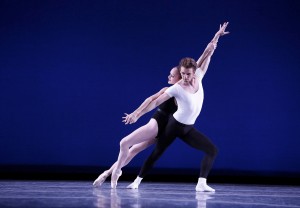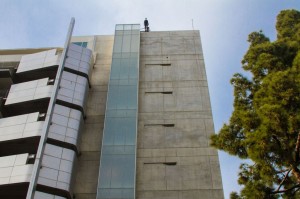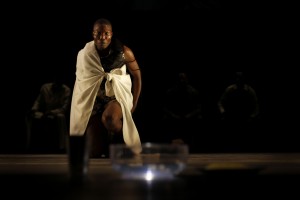With strong flavors of Stravinsky, Balanchine, and Trisha Brown, 2013 was a satisfying year for iconic dance, and dance music, in Los Angeles. The centennial of Stravinsky’s game-changing “Rite of Spring” for Diaghilev’s Ballets Russes delivered unto us both the Joffrey’s faithful reconstruction of the nervy Nijinsky choreography and, earlier in the year, conductor Gustav Dudamel’s first galloping ride conducting the piece with the L.A. Philharmonic. As well, impassioned performances of the standout Stravinsky-Balanchine collaboration “Agon” anchored the programs during Los Angeles Ballet’s two-program ‘Balanchine Festival.’ And to wrap it all up, American Ballet Theatre brought statuesque Marcello Gomes to stride forth as “Apollo,” the one, priceless Stravinsky/Balanchine ballet created for and with Diaghilev in Europe.
Of all these savory treasures, some of the most memorable performances were the Balanchine duets featuring new L.A. Ballet company member Ulrik Birkkjær (also of the Royal Danish Ballet). When partnered by Birkkjær in the Balanchine works, enigmatic L.A. principals Allyssa Bross and Allynne Noelle suddenly — finally — bloomed with youth and vivacity and personality. Hallelujah! More mysteriously and gently riveting was another male L.A. Ballet principal, Zheng Hua Li, dancing in the “Phelgmatic” variation in “The Four Temperaments.” I was completely mesmerized and moved by Zheng’s clear, sustained tension as he danced.
A more effervescent and penetrating look at an artist’s aesthetic was the weekend-long Trisha Brown retrospective presented by CAP-UCLA. It was such a feat to have aerialist dancer Amanda Rudolph (founder of Bandaloop) perform Brown’s “Man Walking Down the Side of a Building,” it totally transfigured the notion of ‘dance’ and ‘timing’ and ‘performance.’ To witness Rudolph’s lifelong passion for and training in aerial dance bump against Brown’s radical urban gesture was a ridiculously giddy moment. Add to that: both indoor and outdoor proscenium concerts, museum installations, panel talks, and a recasting of “Roof Piece” amidst the warm, sun-baked walls and miles-wide vistas of the Getty Center, and you had a weekend event that rotated its audiences’ hearts and minds ten times over. Attendees — who had come from around the world — left with new eyes for seeing dance.
As always, Redcat introduced me to contemporary choreographers who are bringing hypnotizing new material to the dance stage. Samoan choreographer Lemi Ponifasio and his company MAU, based in New Zealand, appeared during the fall Radar Festival with “Stones in Her Mouth,” a visionary portrait of a timeless, archetypal female tribe, hovering in near-darkness, blazing with moments of serenity and heat, coursing power and raw, open wounds. South African choreographer/dancer Gregory Maqoma gave an unforgettable solo performance at Redcat accompanied by South African acapella ensemble Complete and guitarist Giuliano Modarelli. I expected the beautiful heel-digging earthiness; I was caught completely off guard by his delicacy and articulation. (Interesting to note Maqoma studied at Anne Teresa De Keersmaeker’s Belgian dance collective, where Trisha Brown technique is a mainstay.) These performances left mental trails in the air for weeks: in particular, Maqoma and Ponifasio both presented choreography for the human hand that trumps anything I’ve ever seen.
The debut of the Underground, a krump-based performance company founded by Miss Prissy and L’il C, two of the stars of David LaChappelle’s “Rize,” was some of the best news of all. The company brings the energy and spontaneity of the krump circle to the proscenium stage, and features unforgettable dancers from around the country.
Finally, any year with Batsheva-sown choreography is tops for me, and this year L.A. saw two great pieces: Alvin Ailey brought Ohad Naharin’s “Minus 16,” which I could watch on a continuous loop for at least 3 hours, and BodyTraffic tore up Barak Marshall’s dynamic, novel-rich debut “And at midnight, the green bride floated through the village square …” Thickly braided with song, story and spine-tingling ensemble work, Marshall’s piece was an impressive calling card for BodyTraffic, L.A.’s smart new repertory company.




‘Four Temperaments’ is Hindemith, not Stravinsky.
Thanks Eddie. Given the degree of inspired choreography in that piece, it seems like it should be Stravinsky, doesn’t it?
There has never been a more important time in dance, art, music and design than when Diaghilev put it a together. We should learn from the past.